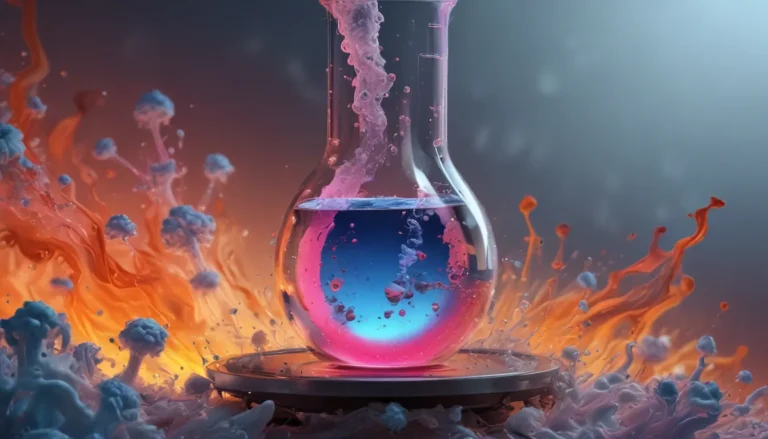A Note About Images: The images used in our articles are for illustration purposes only and may not exactly match the content. They are meant to engage readers, but the text should be relied upon for accurate information.
In the realm of chemistry, catalysts stand out as extraordinary agents that drive chemical reactions and enhance the efficiency of various processes. These remarkable substances have the unique ability to accelerate reactions without being consumed in the process, making them essential in modern industries from organic synthesis to environmental cleanup.
Are you ready to embark on a thrilling journey into the captivating world of catalysts? Join us as we uncover 14 extraordinary facts that showcase the remarkable properties and applications of catalysts. From their historical significance to their role in sustainable chemistry, catalysts have revolutionized numerous fields and continue to shape our understanding of chemical transformations. Get ready to be amazed by the remarkable nature of these unassuming agents of change!
The Marvels of Catalysts:
- Catalysts are like chemical superheroes: They speed up reactions and play a crucial role in the production of everyday products we use. They are the secret ingredient in the recipe for sustainable chemistry.
- Catalysts are the maestros of chemical orchestras: They conduct reactions to create specific products and enhance selectivity. They are the unsung heroes behind many biological processes.
Unveiling the Secrets of Catalysts:
1. Catalysts Facilitate Chemical Reactions
Catalysts are renowned for their ability to speed up reactions by lowering the activation energy required for the reaction to occur. Remarkably, they remain unchanged in the process and can be reused, making them invaluable in various applications.
2. Catalysts in Industrial Processes
From petroleum refining to pharmaceutical manufacturing, catalysts play a critical role in a wide range of industrial processes, enhancing efficiency and reducing costs. Their impact on industries is truly remarkable.
3. Types of Catalysts
Catalysts can be categorized into three main types—homogeneous catalysts in the same phase as the reactants, heterogeneous catalysts in a different phase, and enzyme catalysts derived from biological sources. Each type offers unique advantages in catalyzing reactions.
4. Catalysts’ Acceleration Powers
Some catalysts have the extraordinary ability to accelerate reactions by orders of magnitude, making reactions that would typically take a long time occur rapidly. Their acceleration powers are truly phenomenal.
5. Catalysts in Everyday Products
Catalysts are involved in the production of a myriad of everyday products, including plastics, fertilizers, and pharmaceuticals. Their role in shaping our daily lives is immense and often goes unnoticed.
6. Catalysts and Sustainable Chemistry
By enabling reactions to occur under milder conditions and reducing energy requirements, catalysts contribute to greener and more sustainable chemical processes. They are fundamental in driving the shift towards eco-friendly practices.
7. Tailoring Catalysts for Specific Reactions
Scientists and engineers have the ability to design catalysts with specific properties tailored to optimize their performance for a given reaction. This customization enhances their efficiency and effectiveness in catalyzing reactions.
8. Selective Promotion by Catalysts
In intricate chemical reactions with multiple possible pathways, catalysts play a crucial role in selectively favoring the formation of desired products while suppressing unwanted reactions. Their selectivity is key to achieving desired outcomes.
9. Catalysts’ Vulnerability
Certain substances can inhibit or deactivate catalysts, reducing their activity and potentially limiting their lifespan. Understanding and mitigating catalyst poisoning is essential for maintaining their effectiveness.
10. Catalyst Regeneration
In some cases, catalysts can be regenerated or rejuvenated through processes such as washing, heating, or chemical treatment. This regeneration process prolongs the lifespan of catalysts and ensures their continued efficacy.
11. Synergistic Catalyst Interactions
In complex reactions, multiple catalysts can work in tandem to achieve the desired outcome more efficiently. Their collaborative efforts amplify the catalytic capabilities and broaden the scope of reactions that can be catalyzed.
12. Enhancing Reaction Selectivity
By promoting specific reaction pathways, catalysts enhance the selectivity and yield of desired products, optimizing the reaction for maximum efficiency. Their ability to steer reactions towards specific outcomes is a testament to their precision.
13. Enzymatic Catalysts in Biology
Many biological reactions rely on enzymes as specialized catalysts that enable crucial biological processes to occur under physiological conditions. Enzymes play a vital role in sustaining life processes in living organisms.
14. Catalysts’ Endless Possibilities
Catalysts continue to pose intriguing possibilities and challenges in the realm of chemical reactions. Their diverse applications and unique properties make them a subject of continued research and exploration for scientists and researchers worldwide.
Delving Deeper into the World of Catalysts
As we navigate through the mesmerizing world of catalysis, each discovery unveils new dimensions of their remarkable properties and applications. From the intricate mechanisms of heterogeneous catalysis to the incredible capabilities of enzymes, the realm of catalysis brims with fascinating facts waiting to be unraveled. If you’re eager to expand your knowledge and delve deeper into the enigmatic world of catalysts, join us on this captivating journey of exploration and discovery.
Embracing Catalysts’ Wonders
Catalysts are not mere substances but powerful agents of change that orchestrate chemical reactions with unparalleled efficiency and precision. Their influence spans industries, environmental remediation, and sustainable chemistry, shaping the way we produce, innovate, and safeguard our world. As we embark on a journey of continuous learning and discovery, let us marvel at the ingenuity of catalysts and their enduring impact on the world of chemistry.
Unveiling the Enigmatic Catalysts
Embrace the mysteries and marvels of catalysts as you embark on a journey of discovery and enlightenment. From their exceptional properties to their diverse applications, catalysts are at the forefront of chemical innovation and transformation. Join us in unraveling the enigmatic truths and remarkable feats of these extraordinary substances that have revolutionized the way we perceive chemistry and catalysis.
FAQs: Unraveling Catalysts’ Secrets
Q: What is a catalyst?
A: A catalyst is a substance that accelerates the rate of a chemical reaction without being consumed in the process, enabling reactions to occur more efficiently.
Q: How do catalysts work?
A: Catalysts lower the activation energy required for reactions to take place, providing an alternative pathway for the reaction to proceed at a faster rate.
Q: Can catalysts be reused?
A: Yes, catalysts can be reused multiple times as they are not consumed in the reaction. They may require regeneration or rejuvenation but retain their catalytic activity.
Q: What are some common examples of catalysts?
A: Examples include enzymes in biological systems, platinum in catalytic converters, and zeolites in petrochemical processes, showcasing the diverse applications of catalysts.
Q: Can catalysts control reaction selectivity?
A: Catalysts can influence the selectivity of reactions by favoring specific pathways that lead to desired products, enhancing the efficiency and yield of reactions.
Q: Are catalysts environmentally friendly?
A: In general, catalysts contribute to more sustainable and efficient chemical processes, reducing waste and energy consumption, making them environmentally friendly options.
Q: How are catalysts synthesized?
A: Catalysts can be synthesized through various methods depending on the desired composition and structure, offering flexibility in designing catalysts for specific applications.
Q: Are catalysts safe to use?
A: While some catalysts may contain toxic elements, strict safety measures are implemented during their synthesis and usage to minimize health and environmental risks, ensuring safe handling.
Q: What is the future of catalyst research?
A: Catalyst research continues to evolve, exploring novel reactions, improving catalyst efficiency, and advancing sustainable practices to address global challenges and opportunities in catalysis.
Conclusion: Embracing Catalysts’ Infinite Potential
In the ever-evolving landscape of chemistry, catalysts stand as beacons of innovation and transformation, guiding us towards sustainable practices and groundbreaking discoveries. Their ability to accelerate reactions, enhance selectivity, and drive efficiencies underscores their indispensable role in shaping our world. As we unlock the mysteries of catalysts and embrace their wonders, we pave the way for a future enriched by science, discovery, and the enduring legacy of catalysis.






